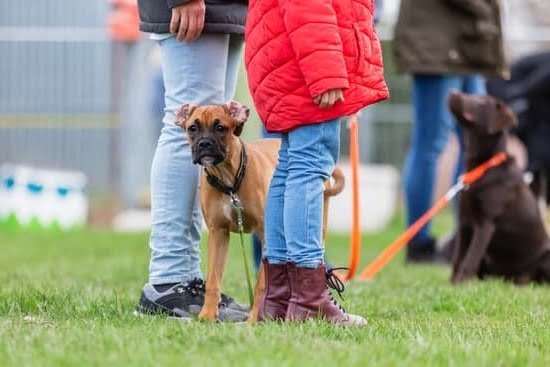Training a dog that was abused can be a challenging but ultimately rewarding experience. Understanding the effects of abuse on dogs is crucial in order to provide the support and training they need to overcome their past experiences.
Recognizing the signs of past abuse in your dog, building trust, establishing a safe environment, and using positive reinforcement techniques are all important aspects of training an abused dog. In this article, we will explore these key steps and provide guidance on how to train a dog that was abused.
Recognizing the signs of past abuse in your dog is the first step in understanding their behavior and needs. Whether it’s fearfulness, aggression, or other behavioral issues, being able to identify these signs can help you tailor your training approach to meet your dog’s specific needs. Building trust and establishing a safe environment are also essential for an abused dog to begin feeling secure and comfortable in their new home.
Using positive reinforcement training techniques, desensitization, counterconditioning, seeking professional help when needed, and maintaining patience and consistency throughout the training process are all vital components of rehabilitating an abused dog. Celebrating small victories and progress along the way is equally important in boosting your dog’s confidence and motivation.
By creating a supportive network for both you and your dog as well as continuing education resources for ongoing training and rehabilitation, you can ensure that you both have the tools necessary for success.
Recognizing Signs of Past Abuse in Your Dog
Dogs that have suffered abuse in the past may exhibit certain signs and behaviors that indicate their traumatic experiences. It is important for pet owners to be able to recognize these signs in order to address and help their dog overcome the effects of abuse. Some common signs of past abuse in dogs include:
- Fearful or aggressive behavior towards humans or other animals
- Excessive shyness or cowering when approached
- Flinching at sudden movements or loud noises
- Unexplained injuries or scars
- Avoidance of certain people, objects, or situations
If you notice any of these behaviors in your dog, it is essential to approach them with patience and understanding.
In addition to behavioral signs, physical indicators such as malnourishment, poor coat condition, and untreated injuries can also point to a history of abuse. Understanding these signs can pave the way for providing the necessary support and rehabilitation for your dog.
By being aware of these signs, dog owners can take proactive steps in creating a safe and supportive environment for their pets as they work towards overcoming the effects of past abuse.
Building Trust and Establishing a Safe Environment
Creating a Safe Space
One of the key steps in training a dog that has been abused is to create a safe and secure environment for them. This includes providing a comfortable bed, access to food and water, and a quiet space where they can retreat when they feel scared or overwhelmed. It’s important to ensure that your dog feels safe in their new surroundings, so providing positive experiences and interactions within the home is crucial.
Establishing Trust Through Consistency
Consistency is key when building trust with an abused dog. Stick to a routine for feeding, walking, and training sessions so that your dog knows what to expect. Avoid sudden movements or loud noises that may startle or frighten them. Taking time to bond with your dog through gentle petting, calming words, and reassuring body language can help build trust over time.
Positive Associations
Create positive associations with people, places, and things by using treats, toys, and praise. For example, if your dog is fearful of new people, have visitors toss treats gently toward the dog without making direct eye contact or approaching too quickly. This will help your dog associate visitors with positive experiences. Similarly, using toys as a form of play therapy can help alleviate stress and build positive associations with you and other members of the household.
By focusing on creating a safe space and establishing trust through consistency and positive associations, you can begin the process of building a strong foundation for training an abused dog. Remember that patience is key during this stage of rehabilitation. Building trust takes time but can ultimately lead to significant progress in your dog’s overall well-being.
Positive Reinforcement Training Techniques
When training a dog that has been abused, it is crucial to use positive reinforcement techniques to help them overcome their past trauma and build trust. Positive reinforcement focuses on rewarding good behavior rather than punishing bad behavior, which can be especially effective for dogs that have experienced abuse.
Here are some positive reinforcement training techniques that can be helpful when working with an abused dog:
– **Clicker training**: Using a clicker to mark the desired behavior and then rewarding the dog with a treat can help them associate the sound of the clicker with good behavior.
– **Treat-based training**: Using high-value treats as rewards for positive behavior can motivate the dog to repeat those behaviors in the future.
– **Praise and affection**: Providing verbal praise, petting, and affection when the dog behaves well can also reinforce positive behaviors.
It’s essential to be patient and consistent when using these techniques, as it may take time for an abused dog to learn to trust and understand that good behavior results in positive outcomes. By focusing on reinforcing good behavior, you can help your dog build confidence and overcome the effects of past abuse.
Desensitization and Counterconditioning
Understanding Desensitization
Desensitization involves gradually exposing the dog to the trigger or stimulus that causes fear or anxiety, starting at a very low intensity and gradually increasing it over time. This gradual exposure allows the dog to become more accustomed to the trigger without becoming overwhelmed, ultimately reducing their fear response.
Implementing Counterconditioning
Counterconditioning involves changing the dog’s emotional response to the trigger by associating it with something positive. For example, if a dog is afraid of other dogs due to past abuse, you can use counterconditioning by pairing the sight of other dogs with something enjoyable for your dog, such as treats or playtime. Over time, this can help the dog form positive associations with previously fear-inducing stimuli.
It’s important to note that desensitization and counterconditioning should be implemented with caution and under the guidance of a professional trainer or behaviorist, especially when dealing with severely traumatized dogs. The process requires patience, consistency, and an understanding of your dog’s individual needs in order to be successful. With dedication and proper training, these techniques can play a crucial role in helping abused dogs overcome their past experiences and lead fulfilling lives.
Seeking Professional Help and Guidance
When it comes to training a dog that has been abused, seeking professional help and guidance is crucial. A professional dog trainer or animal behaviorist can provide valuable insight into your dog’s unique needs and behaviors. Additionally, they can offer personalized training plans and effective techniques to address the specific issues resulting from past abuse.
Before consulting a professional, it is important to do thorough research and find someone who has experience working with abused dogs. Look for individuals who have a background in positive reinforcement-based training methods and a deep understanding of trauma-related behaviors in canines. A qualified professional will be able to assess your dog’s behavior, identify triggers, and recommend appropriate strategies for rehabilitation.
It is also worth noting the importance of finding a vet who specializes in behavioral medicine. In some cases, the effects of abuse on a dog may manifest as physical health concerns. A veterinary behaviorist can offer medical interventions, such as medication or dietary adjustments, to support your dog’s emotional well-being alongside their behavioral training.
| Professional Help | Guidance |
|---|---|
| A trained animal behaviorist helps address unique needs. | Ensure they have positive reinforcement training methods expertise. |
| Find a vet specializing in behavioral medicine. | They provide support for the dog’s emotional well-being alongside behavioral training. |
Patience and Consistency in Training
Training a dog that has been abused requires an incredible amount of patience and consistency. These dogs have likely gone through traumatic experiences and may be fearful or anxious as a result. It’s important to approach training with understanding and empathy, rather than frustration or anger. When working with an abused dog, it’s crucial to remember that progress may be slow, and setbacks are to be expected.
Consistency is key when training any dog, but especially so for those who have experienced abuse. Set clear boundaries and rules for your dog, and stick to them consistently. This will help your dog feel safe and secure in their environment, knowing what is expected of them. Additionally, consistency in training will help build trust with your dog as they learn that they can rely on you for guidance and support.
It’s important not to rush the training process with an abused dog. Pushing too hard or too fast can lead to setbacks or cause the dog further distress. Instead, focus on small steps and gradual progress. Celebrate even the smallest victories in training, such as a fearful dog approaching a new person or learning a simple command like “sit”. Over time, these small wins will add up to significant progress in building confidence and trust in the dog.
| Aspect of Training | Description |
|---|---|
| Patience | Understanding that progress may be slow due to past trauma. |
| Consistency | Setting clear boundaries and rules, maintaining predictability for the dog. |
| Celebrating Progress | Acknowledging even small improvements as significant accomplishments. |
Celebrating Small Victories and Progress in Training
It is crucial to celebrate small victories and progress when training a dog that has been abused. These dogs have likely experienced trauma and may have trust issues, so any sign of improvement should be acknowledged and celebrated. Whether it’s mastering a new command, showing less fear in certain situations, or displaying more confidence, every step forward is an achievement worth recognizing.
By celebrating these small victories, you are not only reinforcing positive behavior in your dog but also boosting their confidence and trust in you as their owner. Positive reinforcement through praise, treats, and affection can go a long way in building a strong bond with your dog and helping them overcome the effects of their past abuse. It also creates a more positive training experience for both you and your pet.
It’s important to remember that progress may not always be linear, and there may be setbacks along the way. However, by focusing on the small successes and acknowledging the progress your dog is making, you can stay motivated and continue to work towards their rehabilitation. Additionally, keeping track of these victories can serve as a reminder of how far your dog has come, especially during challenging moments in their training journey.
Creating a Supportive Network for Both You and Your Dog
Support from others who have experience with abused dogs can be incredibly helpful as you navigate the journey of training and rehabilitating your dog. Look for local support groups, online forums, or social media communities where you can connect with other dog owners who have gone through similar experiences. Sharing stories, advice, and encouragement with people who understand what you are going through can provide a sense of belonging and comfort during challenging times.
Additionally, consider seeking out professionals such as veterinarians, behaviorists, or trainers who specialize in working with abused animals. These experts can offer guidance, reassurance, and practical tools to help you better understand your dog’s needs and behaviors. Don’t hesitate to ask for help when needed – building a supportive network of knowledgeable individuals can make a significant difference in the rehabilitation process.
Furthermore, it’s important to take care of yourself while caring for an abused dog. Just as your pet needs emotional support, so do you.
Surround yourself with friends and family members who can offer a listening ear and provide emotional support as you navigate the challenges of training a previously abused animal. Self-care is essential in this process; make it a priority to seek out your own support system to help manage any stress or emotions that may arise along the way.
Continuing Education and Resources for Ongoing Training and Rehabilitation
In conclusion, training a dog that has been abused requires patience, understanding, and a commitment to ongoing education and resources. It is crucial to recognize the effects of abuse on dogs and to be able to identify the signs of past trauma in your pet. Building trust and creating a safe environment for your dog are essential first steps in the rehabilitation process.
Positive reinforcement training techniques, desensitization, and counterconditioning are effective ways to help your dog overcome their fear and anxiety from past abuse. Seeking professional help and guidance can provide valuable support and expertise in dealing with the specific needs of an abused dog.
It’s important to celebrate small victories and progress in your dog’s training, as well as to create a supportive network for both you and your pet. Finally, continuing education and access to resources for ongoing training and rehabilitation will ensure that you have the tools and knowledge needed to help your abused dog heal and thrive.
With patience, consistency, and dedication, it is possible for dogs that have been abused to recover from their past trauma and live happy, fulfilling lives with loving owners.
Frequently Asked Questions
Can an Abused Dog Ever Recover?
An abused dog can indeed recover with the right care, patience, and support. It may take time, but with proper rehabilitation, love, and positive reinforcement, many abused dogs are able to overcome their past traumas and learn to trust humans again.
How Do You Rehabilitate a Dog That Has Been Abused?
Rehabilitating an abused dog involves creating a safe and nurturing environment for the dog to rebuild trust and confidence. This may include gentle training methods, socialization with other dogs and humans, as well as providing a consistent routine and plenty of positive reinforcement.
Seeking professional help from a qualified dog trainer or animal behaviorist may also be beneficial in rehabilitating an abused dog.
Can Abused Dogs Change?
Yes, abused dogs have the potential to change. While they may carry emotional scars from their past experiences, many abused dogs can learn to trust again, form healthy relationships with humans and other animals, and lead fulfilling lives.
With patience, understanding, and positive reinforcement, an abused dog can go through a remarkable transformation and learn to live without fear or anxiety.

Welcome to the blog! I am a professional dog trainer and have been working with dogs for many years. In this blog, I will be discussing various topics related to dog training, including tips, tricks, and advice. I hope you find this information helpful and informative. Thanks for reading!





